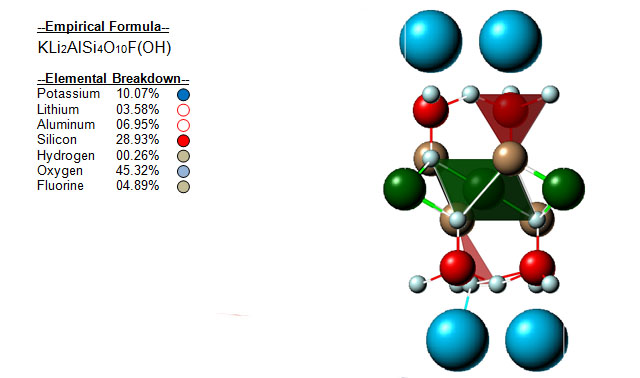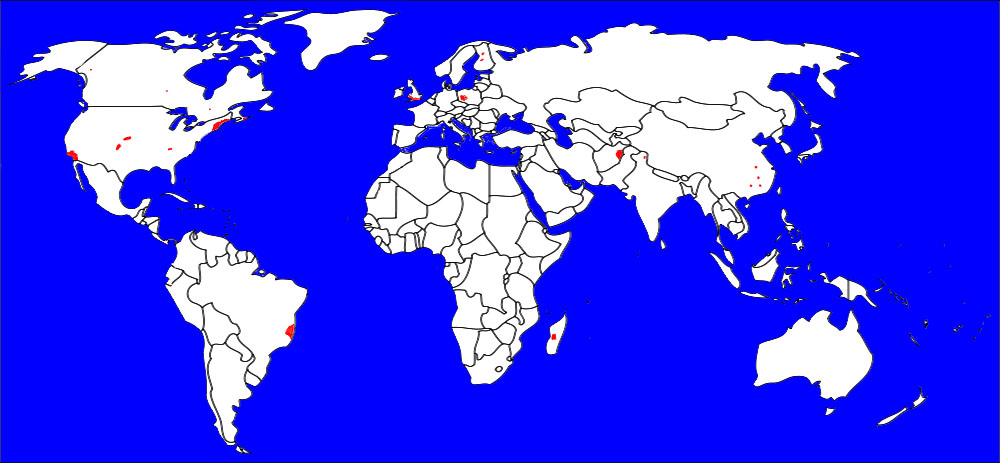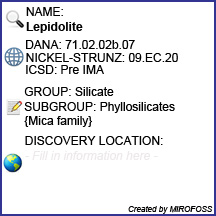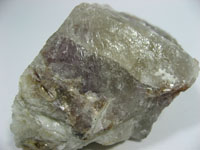![]()
Lepidolite is a lilac-gray or rose coloured phyllosilicate mineral of the mica group that is a secondary source of lithium. Lepidolite is associated with other lithium-bearing minerals like spodumene in pegmatite bodies. It is one of the major sources of the rare alkali metals rubidium and cesium. In 1861 Robert Bunsen and Gustav Kirchhoff extracted 150 kg of lepidolite and yielded a few grams of rubidium salts for analysis, and therefore discovered the new element rubidium.
![]()
Within the metaphysical realm of minerals, Lepidolite aids in overcoming any kind of emotional or mental dependency, supporting in the release of addictions and complaints of all kinds, including anorexia. It encourages independence and self love and trust. Lepidolite combines its power of objectivity with direction and unimpeded communication, focusing on what is important and making it an excellent stone for business pursuits.
Please note that MIROFOSS does not suggest in any way that minerals should be used in place of proper medical and psychological care. This information is provided here as a reference only.
![]() Lepidolite is used as an ore to extract rare earth elements such as lithium, cesium, and rubidium.
Lepidolite is used as an ore to extract rare earth elements such as lithium, cesium, and rubidium.
![]()
Lepidolite may be found in aplites associated with granite pegmatite. It is rarely found in hydrothermal veins and extremely rarely in granite contact zones.
![]()
Lepidolite occurs in granite pegmatites, in some high-temperature quartz veins, greisens, and granites. Associated minerals include quartz, feldspar, spodumene, amblygonite, tourmaline, columbite, cassiterite, topaz, and beryl. Notable occurrences of Lepidolite can be found in Brazil; Ural Mountains, Russia; California; Tanco Mine, Bernic Lake, Manitoba, Canada; and Madagascar.
Other than in the basic mineral form, lepidolite can be found in three distinct varieties:
![]()
| Cleavage | Perfect | |
| Colour(s) | Colourless, Gray white, Lilac, Yellowish white | |
| Specific Gravity | 2.84 | |
| Diaphaneity | Translucent | |
| Fracture | Uneven – flat surfaces fractured in an uneven pattern | |
| Mohs Hardness | 2.5 to 3.0 | |
| Luminescence | Non-fluorescent | |
| Lustre | Vitreous to Pearly | |
| Streak | White | |
| Habit(s) | Crystalline to Disseminated to Massive | |
| Radioactivity | Lepidolite per GRapi unit = 143.68 | |
| Magnetism | Non-magnetic |
![]()
The following health hazards should be noted when handling lepidolite
 |
RADIOACTIVE Slightly detectable radioactivity |
![]()
The following image shows the Elemental breakdown of the mineral lepidolite along with the mineral crystal structure.

![]()
| Crystal System | Monoclinic |  |
| Class | Group C | |
| Axial Ratios | a : b : c = 0.5808 : 1 : 2.2474 | |
| Tenacity | Elastic | |
| Optical Data Type | Biaxial (-) | |
| Pleochroism (x) | Colourless | |
| Pleochroism (y) | Colourless | |
| Pleochroism (z) | N/A | |
| RL Values | N/A | |
| 2V | N/A | |
| Max Birefringence | No Birefringence Available | |
| Surface Relief | High | |
| Dispersion | Weak r > v |
![]()
Lepidolite can be referenced in certain current and historical texts under the following seven names:
The mineral lepidolite can be translated into the following select languages:
| Arabic | اللبيدوليت | Bulgarian | Chinese (Sim) | 锂云母 | |
| Croatian | lepidolit | Czech | Lepidolit | Danish | |
| Dutch | Lepidoliet | Esperanto | Estonian | ||
| Finnish | Lepidoliitti | French | German | Lepidolit | |
| Greek | Hebrew | Hungarian | Lepidolit | ||
| Italian | Japanese | リチア雲母 | Korean | 레삐 | |
| Latin | Lithuanian | Norwegian | |||
| Persian | لپدولیت | Polish | Lepidolit | Portuguese | |
| Romanian | Russian | Лепидолит | Slovak | Lepidolit | |
| Spanish | Lepidolita | Swedish | lepidolit | Tagalog | |
| Turkish | Lepidolit | Ukrainian | лепідоліт | Vietnamese |
![]()
Lepidolite can be found in a few places around the world. The map below shows major documented concentrations of lepidolite:

![]()
 |
The MIROFOSS database offers free printable geological identification tags for personal and non-profit use. These tags can be used to properly identify mineral samples in your collection. -Click here- to download a full size jpeg image for a lepidolite identification tag; which can be printed on paper or used with a plastic laser printer. |
 |
What's this? What can I do with it? |
![]()
| Chemical Composition | Stevens, Rollin Elbert (1938), New analyses of lepidolites and their interpretation: American Mineralogist: 23: 607-628. Kogure, T. and Bunno, M. (2004) Investigation of polytypes in lepidolite using electron back-scattered diffraction. American Mineralogist: 89: 1680-1684. |
| Crystallography | Schaller, Waldemar Theodore (1905), Crystallography of lepidolite: American Journal of Science, 4th. Series: 19: 225-226 |
| History | Canadian Mineralogist (1998): 36: 905-912 Mineralogical Magazine (1999): 63: 267-279 |
| Geographical Data | Mindat.org. Retrieved on 2012-03-15 |
| Physical Identification | Webmineral.com. Retrieved on 2012-03-15. |
| March 15, 2012 | The last time this page was updated |
| ©2017 MIROFOSS™ Foundation | |
 |
|






